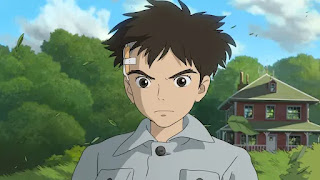Esteemed director Hayao Miyazaki's The Boy and the Heron is billed as the 82-year-old master's last film, following such movies as Spirited Away (2001) and Princess Mononoke (1997).
I wish I could say that Miyazaki's swan song was an unalloyed delight but I watched it with a conscious sense that a gifted animator was applying high levels of artistry to a story that focuses on a lonely boy.
Put another way, I was more attuned to Miyazaki's display of craft than to the story and its characters, even while chuckling over the director's willingness to fill the screen with wild ideas.
The Boy and Heron begins with its feet planted firmly in reality: Twelve-year-old Mahito suffers a terrible loss during the waning days of World War II when his mother dies in a fire at a hospital.
Time passes and Mahito moves to the country with his father, an engineer who's now married to the pregnant sister of his late wife.
The boy's isolation becomes palpable as he tries to adjust to a new environment. After he's attacked by bullies, Mahito slams his head with a rock so that he won't have to return to school.
True to the movie's title, Mahito is tormented by a pesky heron, a creature connected to the fateful turn the story will take.
The boy's encounter with the persistent heron, his head injury, and a visit to a mysterious tower that's supposed to be off limits allow Miyazaki to open the film's visual flood gates.
Mahito travels through an alternate reality he enters while visiting the forbidden tower. Pelicans display the personalities of vultures. A menacing army of giant parakeets marches to the orders of their narcissistic king. Floating creatures called Warawara represent the souls of yet-to-be-born humans.
The heron becomes a hybrid figure, a man/bird who reluctantly agrees to help Mahito return home.
Did I mention that Mahito also becomes responsible for the return of his stepmother who's also visiting this world? Or that he meets a young woman with mysterious powers and a sailor and ...
Let's just say that the story becomes overly crowded, simultaneously enchanting and confusing, funny and ominous.
If one wanted to abstract a theme from The Boy and the Heron, it might center on the interaction between fantasy and the reality, how the former can help one live in the latter.
I'd argue that The Boy and the Heron could have benefited from a stronger narrative through-line. Or maybe that's just me. Perhaps Miyazaki's fans won't mind, but if this is his last movie, it would have felt good to review it without reservation.

1 comment:
When film maker is a a giant in the way Miyazaki is, it's difficult to give critiques because it seems like he should be the arbiter of what makes a quality animation. However, looking through the lens of three act story structure, it's a simple task to point out that the narrative beats are either blatantly mistimed, absent, or ineffective. Much of the time, it's stories that are intimately aware of story structure which are able to produce strong emotional beats, and the film's lacking attempts at those highlight the missing narrative through line.
Storyboarding/animation-first filmmaking has limitations, and those have been visible in the culmination of Miyazaki's work for a long time. It's so much more reliable to intentionally integrate distinct themes and plot with a writing/plotting-first approach.
Stories like Princess Mononoke and Spirited Away are in the unique state of having all the charm that comes with a prioritized emphasis on animation, while also having characters with trackable motivations that push through the story. It's far from cookie-cutter, Save-the-Cat structure, but it allows the audience to at least orient themselves throughout the runtime. The Boy and Heron does not give that same luxury.
Maybe the most disappointing aspect of the film is that it seems to promise growth in or between characters, but there simply is no attempt to show that (point and case being the main character calling his step-mom Mother after nothing has changed between them, as far as the audience is concerned). In Mononoke, the MC learns, through following his motivation to protect his village and the forest animals, that people are complex and untangling environmental issues is an insane problem. Chihiro, by following her want of getting her parents back to normal, learns that she has tenacity and can form meaningful bonds with people through work and shared experience. I don't know what Mahito was supposed to have learned (besides, loosely, to face the real world) or why he cared so much about retrieving his step-mother when he clearly should have cared more for his biological mother, who is also accessible to him in the same way and place. The film pretends not to notice this at multiple points.
I'm sure this film has extraordinary personal and familial value, but it doesn't operate in a decipherable way for a mainstream (Western???) audience. Meanwhile, How Do You Live? is an ethics book highly contextual to Japanese history, culture, and norms which is completely decipherable for mainstream, Western readers.
¯\_(ツ)_/¯
I'm sure historical and biographical context would help make sense of this film, but a movie that only operates symbolically only has partial meaning. Coincidentally, Howl's Moving Castle suffers for similar reasons.
Miyazaki will be remembered as the man who forced eastern animated film into the North American spotlight through his passion for and dedication to his craft, no matter how any of his films are received. But, man, I wish this one had been better.
Post a Comment